CHEVROLET S10 1995 2.G Owners Manual
Manufacturer: CHEVROLET, Model Year: 1995, Model line: S10, Model: CHEVROLET S10 1995 2.GPages: 354, PDF Size: 18.92 MB
Page 211 of 354
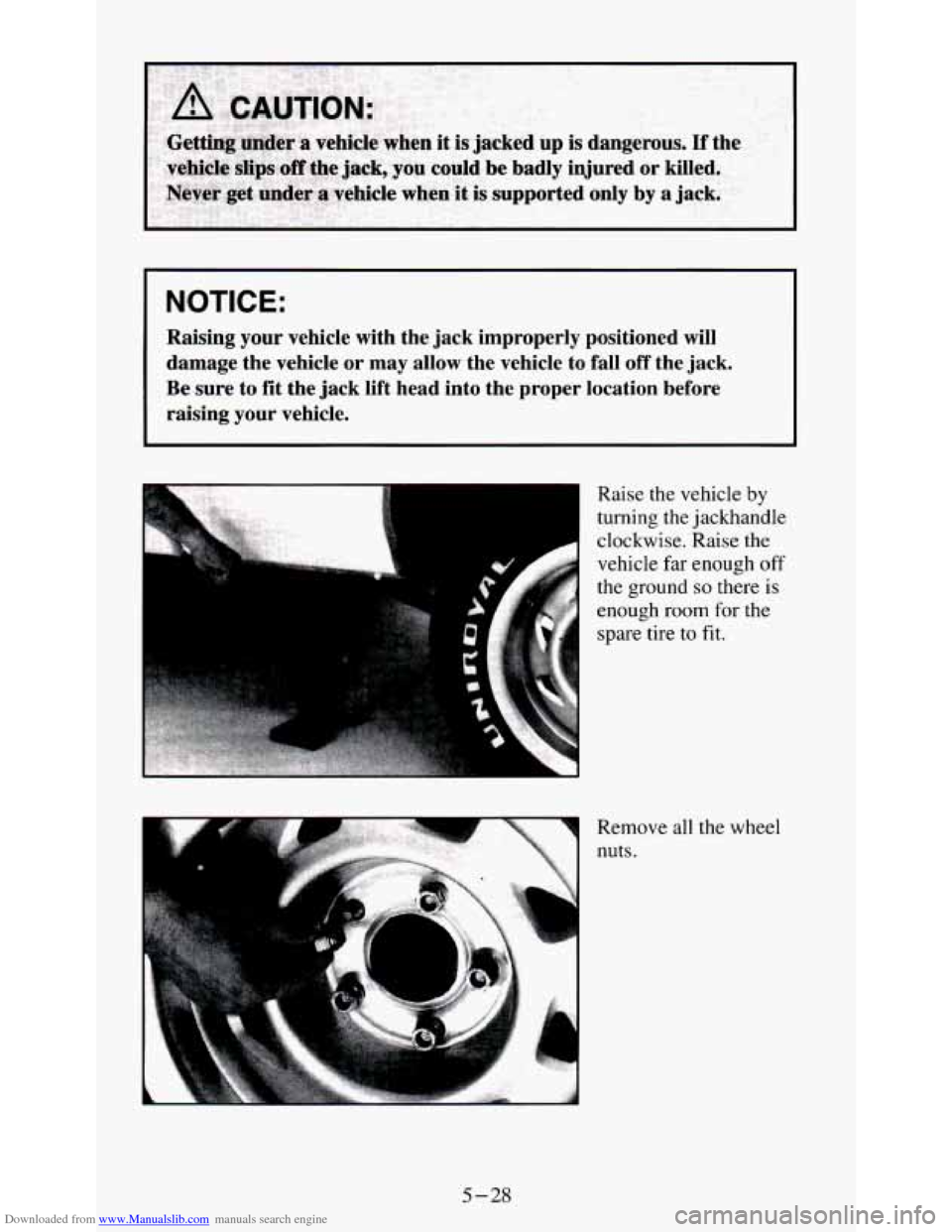
Downloaded from www.Manualslib.com manuals search engine NOTICE:
Raising your vehicle with the jack improperly positioned will
damage the vehicle
or may allow the vehicle to fall off the jack.
Be sure to fit the jack lift head into the proper location before
raising your vehicle.
Remove all the wheel
nuts. Raise the vehicle
by
turning the jackhandle
clockwise. Raise the
vehicle far enough
off
the ground so there is
enough
room for the
spare tire
to fit.
5-28
Page 212 of 354
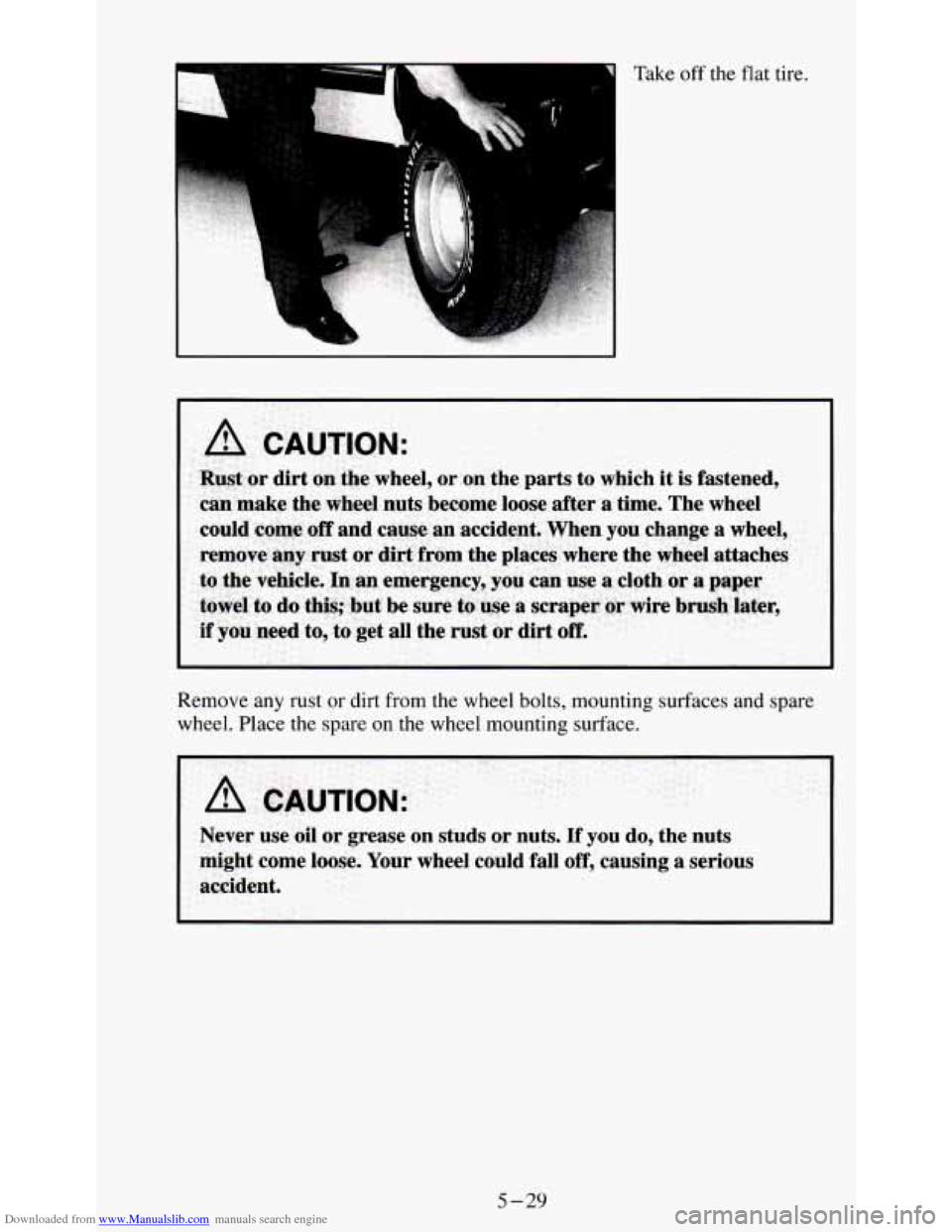
Downloaded from www.Manualslib.com manuals search engine Take off the flat tire.
Remove any rust or dirt from the wheel bolts, mounting surfaces and spare
wheel. Place the spare
on the wheel mounting surface.
Never use oil or grease on studs or nuts. If you do, the nuts
might
come loose. Your wheel could fall off, causing a serious
accident.
5-29
Page 213 of 354
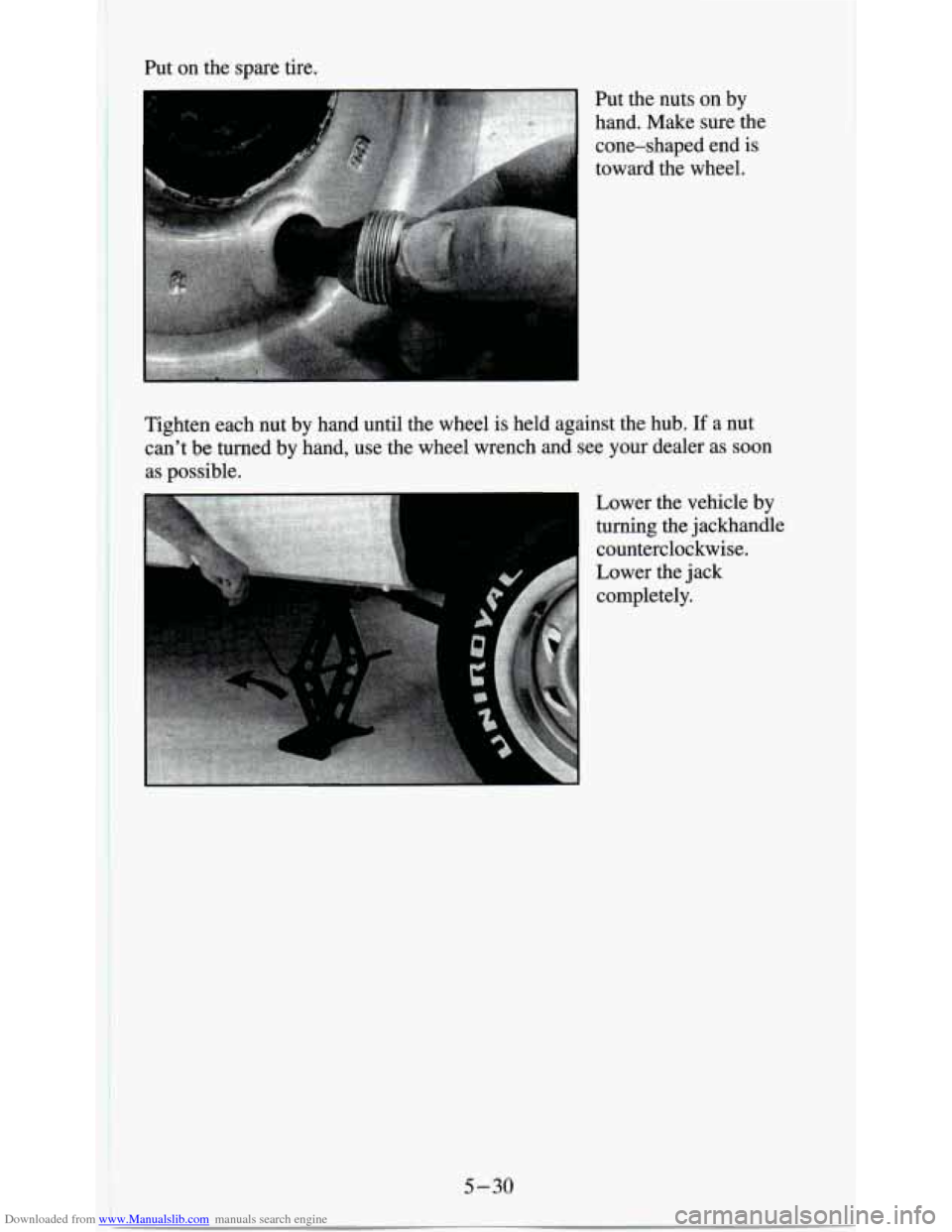
Downloaded from www.Manualslib.com manuals search engine Put on the spare tire.
Put the nuts on by
hand.
Make sure the
cone-shaped end is
toward the wheel.
I ~~~~,,~.;"~,'~~~~~~.~~~ . ;,~,$ + ii ,,
Tighten each nut by hand until the wheel is held against the hub. If a nut
can't be turned by hand, use the wheel wrench and see your dealer as soon
as possible.
Lower the vehicle by
turning the jackhandle
counterclockwise.
Lower the jack
completely.
I 5-30 ~
i
Page 214 of 354
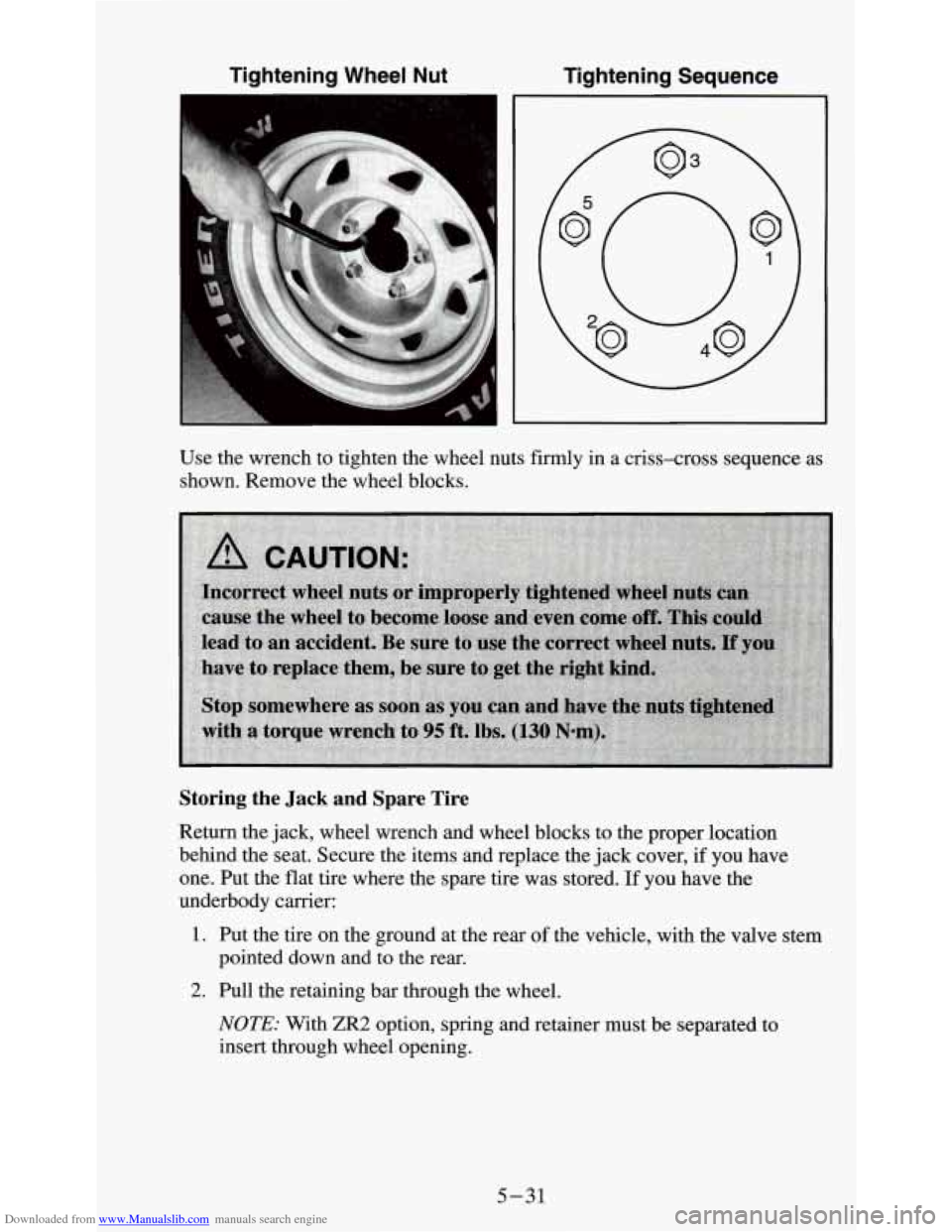
Downloaded from www.Manualslib.com manuals search engine Tightening Wheel Nut Tightening Sequence
,
Use the wrench to tighten the wheel nuts firmly in a criss-cross sequence as
shown. Remove the wheel blocks.
Storing the Jack and Spare Tire
Return the jack, wheel wrench and wheel blocks to the proper location
behind the seat. Secure the items and replace the jack cover,
if you have
one. Put the flat tire where the spare tire was stored.
If you have the
underbody carrier:
1. Put the tire on the ground at the rear of the vehicle, with the valve stem
pointed down and to the rear.
2. Pull the retaining bar through the wheel.
NOTE: With ZR2 option, spring and retainer must be separated to
insert through wheel opening.
5-31
Page 215 of 354
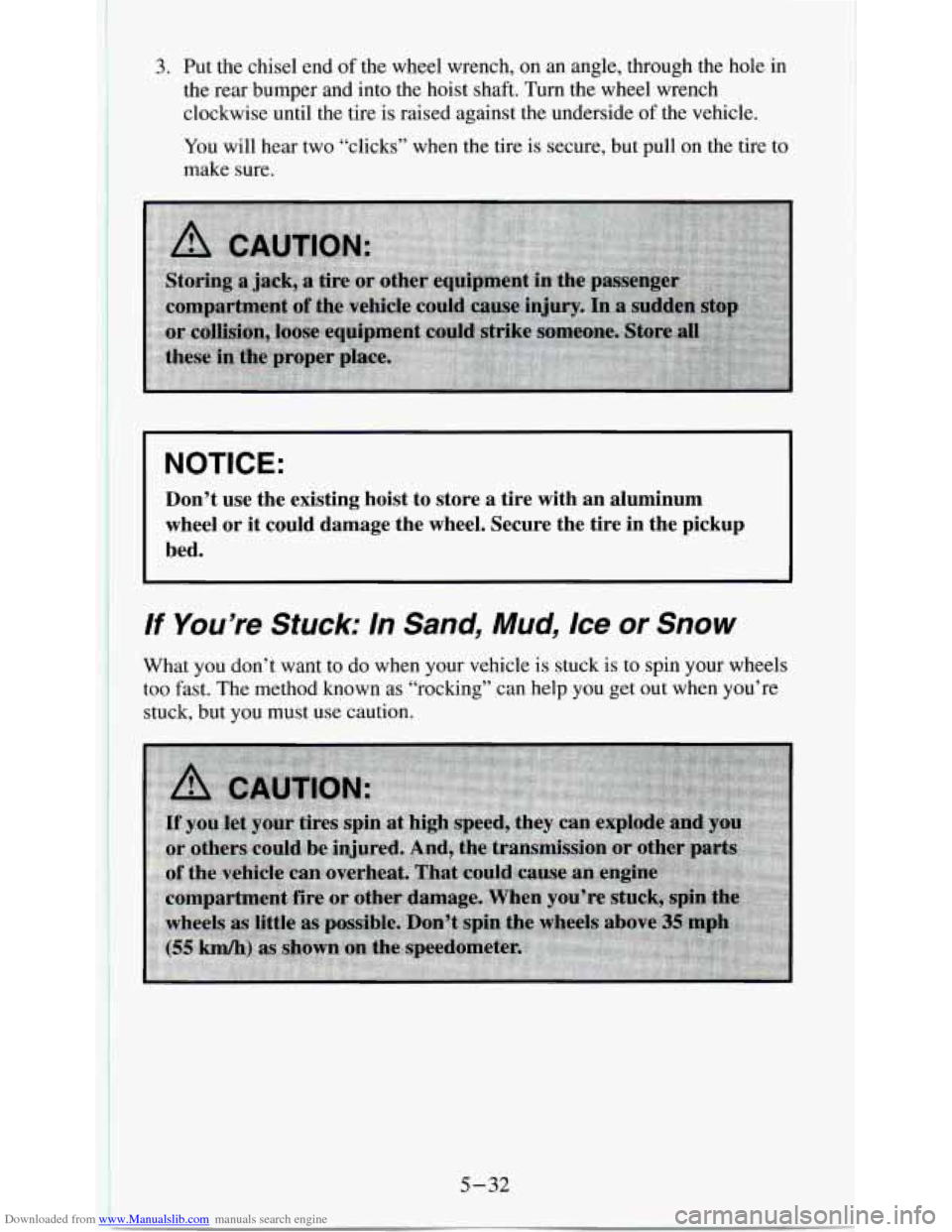
Downloaded from www.Manualslib.com manuals search engine 3. Put the chisel end of the wheel wrench, on an angle, through the hole in
the rear bumper and into the hoist shaft. Turn the wheel wrench
clockwise until the tire is raised against the underside
of the vehicle.
You will hear two “clicks” when the tire is secure, but pull on the tire to
make sure.
I NOTICE:
Don’t use the existing hoist to store a tire with an alumi\
num
wheel
or it could damage the wheel. Secure the tire in the pickup
bed.
If You’re Stuck: In Sand, Mud, Ice or Snow
What you don’t want to do when your vehicle is stuck is to spin your wheels
too fast. The method known as “rocking” can help
you get out when you’re
stuck, but you must use caution.
5-32
Page 216 of 354

Downloaded from www.Manualslib.com manuals search engine NOTICE:
Spinning your wheels can destroy parts of your vehicle as well\
as
the tires. If you spin the wheels too fast while shifting you\
r
transmission back and forth, you can destroy your transmission. \
For information about using tire chains on your vehicle, see “Tire Chains”
in the Index.
Rocking your vehicle to get it out:
First, turn your steering wheel left and right. That will clear the area around
your front wheels. Then shift back and forth between REVERSE (R) and a
forward gear (or with a manual transmission, between FIRST
(1) or
SECOND
(2) gear and REVERSE), spinning the wheels as little as possible.
Release the accelerator pedal while you shift, and press lightly
on the
accelerator pedal when the transmission
is in gear. If that doesn’t get you
out after a few tries, you may need to be towed out. Or, you can use your
recovery hooks, if your vehicle has them.
If you do need to be towed out,
see “Towing Your Vehicle” in the Index.
Using the Recovery Hooks
Your vehicle may be equipped with recovery hooks. The recovery hooks are
provided at the front of your vehicle. You may need to use them
if you’re
stuck off-road and need to be pulled to some place where you can continue
driving.
5-33
Page 217 of 354
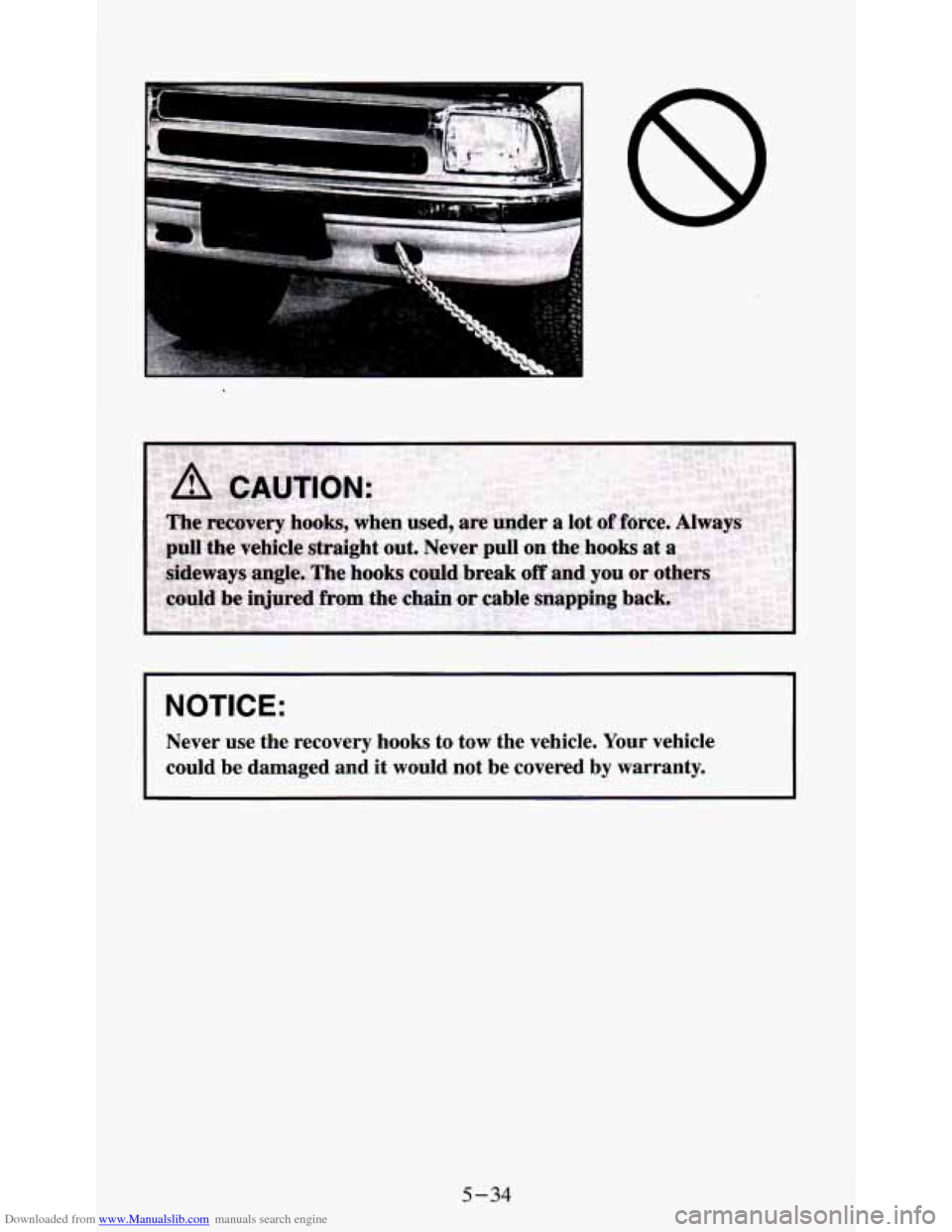
Downloaded from www.Manualslib.com manuals search engine NOTICE:
Never use the recovery hooks to tow the vehicle. Your vehicle
could be damaged and it would not be covered by warranty.
5-34
Page 218 of 354
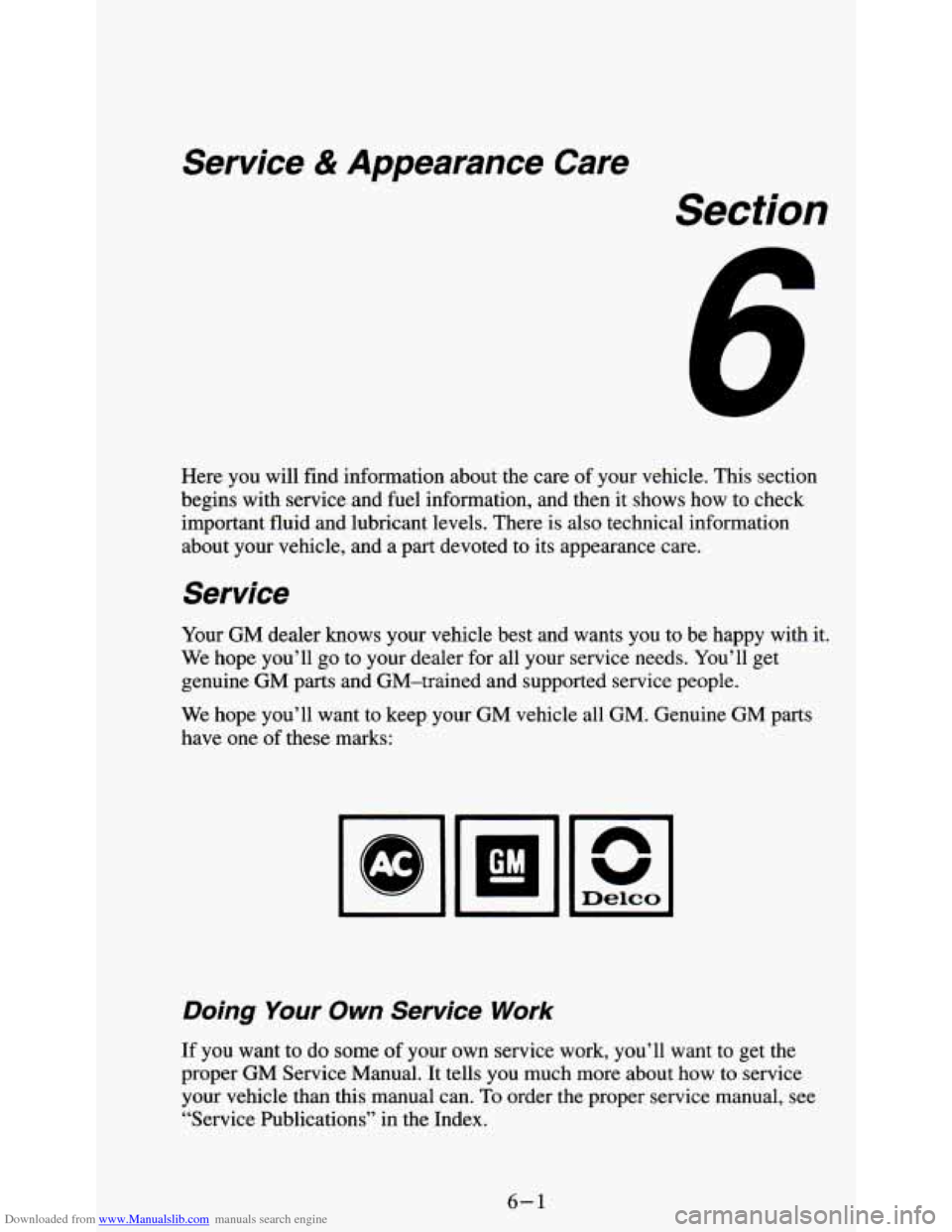
Downloaded from www.Manualslib.com manuals search engine Service & Appearance Care
Section
Here you will find information about the care of your vehicle. This section
begins with service and fuel information, and then it shows how to check
important fluid and lubricant levels. There is also technical information
about your vehicle, and a part devoted to its appearance care.
Service
Your GM dealer knows your vehicle best and wants you to be happy with it.
We hope you’ll go to your dealer for all your service needs. You’ll get
genuine GM
parts and GM-trained and supported service people.
We hope you’ll want to keep your GM vehicle all GM. Genuine GM parts
have one
of these marks:
Doing Your Own Service Work
If you want to do some of your own service work, you’ll want to get the
proper
GM Service Manual. It tells you much more about how to service
your vehicle than this manual can.
To order the proper service manual, see
“Service Publications” in the Index.
6-1
Page 219 of 354
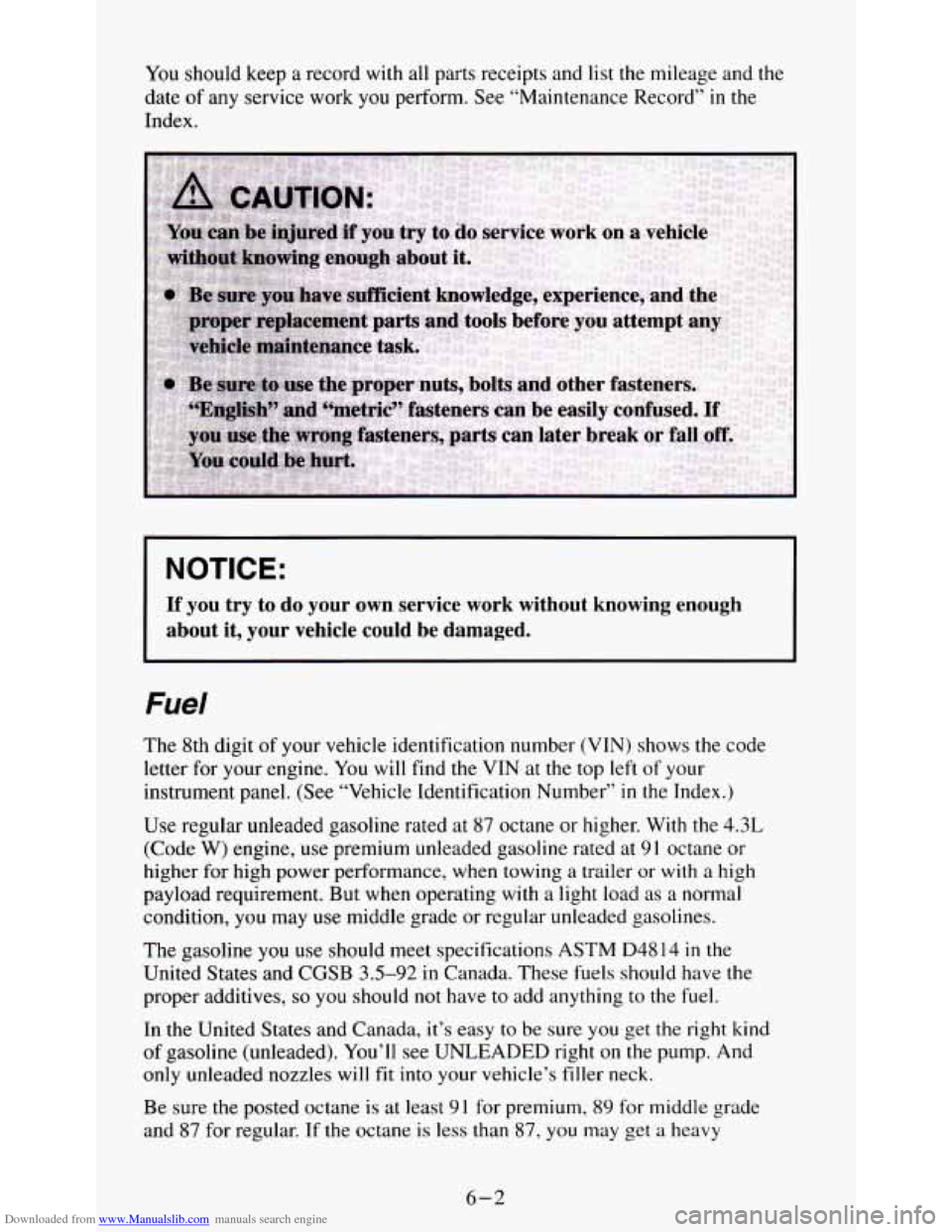
Downloaded from www.Manualslib.com manuals search engine You should keep a record with all parts receipts and list the mileage and the
date
of any service work you perform. See “Maintenance Record” in the
Index.
NOTICE:
If you try to do your own service work without knowing enough
about it, your vehicle could be damaged.
Fuel
The 8th digit of your vehicle identification number (VIN) shows the code
letter for your engine. You will find the VIN at the top left
of your
instrument panel. (See “Vehicle Identification Number”
in the Index.)
Use regular unleaded gasoline rated at 87 octane or higher. With the
4.3L
(Code W) engine, use premium unleaded gasoline rated at 9 1 octane or
higher for high power performance, when towing
a trailer or with a high
payload requirement. But when operating with a light load
as a normal
condition, you may use middle grade or regular unleaded gasolines.
The gasoline you use should meet specifications
ASTM D48 14 in the
United States and CGSB
3.5-92 in Canada. These fuels should have the
proper additives,
so you should not have to add anything to the fuel.
In the United States and Canada, it’s easy to be sure you get the right kind
of gasoline (unleaded). You’ll see UNLEADED right on the pump. And
only unleaded nozzles will fit into your vehicle’s filler neck.
Be sure the posted octane
is at least 91 for premium, 89 for middle grade
and 87 for regular. If the octane
is less than 87, you may get a heavy
6-2
Page 220 of 354
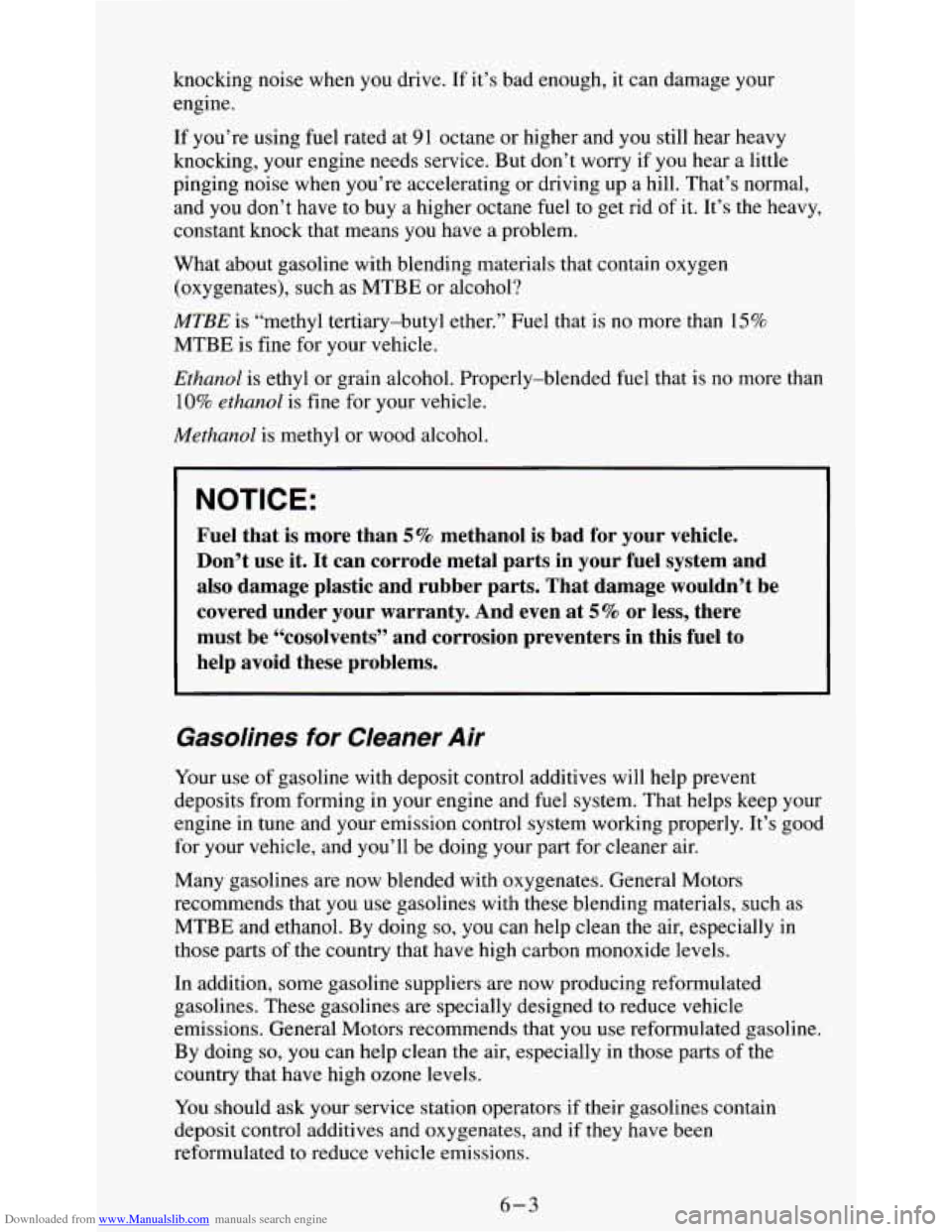
Downloaded from www.Manualslib.com manuals search engine knocking noise when you drive. If it’s bad enough, it can damage your
engine.
If you’re using fuel rated at
91 octane or higher and you still hear heavy
knocking, your engine needs service. But don’t worry if
you hear a little
pinging noise when you’re accelerating or driving up a hill. That’s normal,
and
you don’t have to buy a higher octane fuel to get rid of it. It’s the heavy,
constant knock that means
you have a problem.
What about gasoline with blending materials that contain oxygen
(oxygenates), such as MTBE or alcohol?
MTBE is “methyl tertiary-butyl ether.” Fuel that is no more than 1 5%
MTBE is fine for your vehicle.
Ethanol is ethyl or grain alcohol. Properly-blended fuel that is no more than
10% ethanol is fine for your vehicle.
Methanol is methyl or wood alcohol.
NOTICE:
Fuel that is more than 5% methanol is bad for your vehicle.
Don’t use it. It can corrode metal parts in your fuel syst\
em and also damage plastic and rubber parts. That damage wouldn’t b\
e
covered under your warranty. And even at
5% or less, there
must be “cosolvents” and corrosion preventers in this fuel\
to
help avoid these problems.
Gasolines for Cleaner Air
Your use of gasoline with deposit control additives will help prevent
deposits from forming in your engine and fuel system. That helps keep your
engine
in tune and your emission control system working properly. It’s good
for your vehicle, and you’ll be doing your part for cleaner air.
Many gasolines are now blended with oxygenates. General Motors
recommends that you use gasolines with these blending materials, such as
MTBE and ethanol. By doing
so, you can help clean the air, especially in
those parts of the country that have high carbon monoxide levels.
In addition, some gasoline suppliers are now producing reformulated
gasolines. These gasolines are specially designed
to reduce vehicle
emissions. General Motors recommends that you use reformulated gasoline.
By doing
so, you can help clean the air, especially in those parts of the
country that have high ozone levels.
You should ask your service station operators if their gasolines contain
deposit control additives and oxygenates, and
if they have been
reformulated to reduce vehicle emissions.
6-3